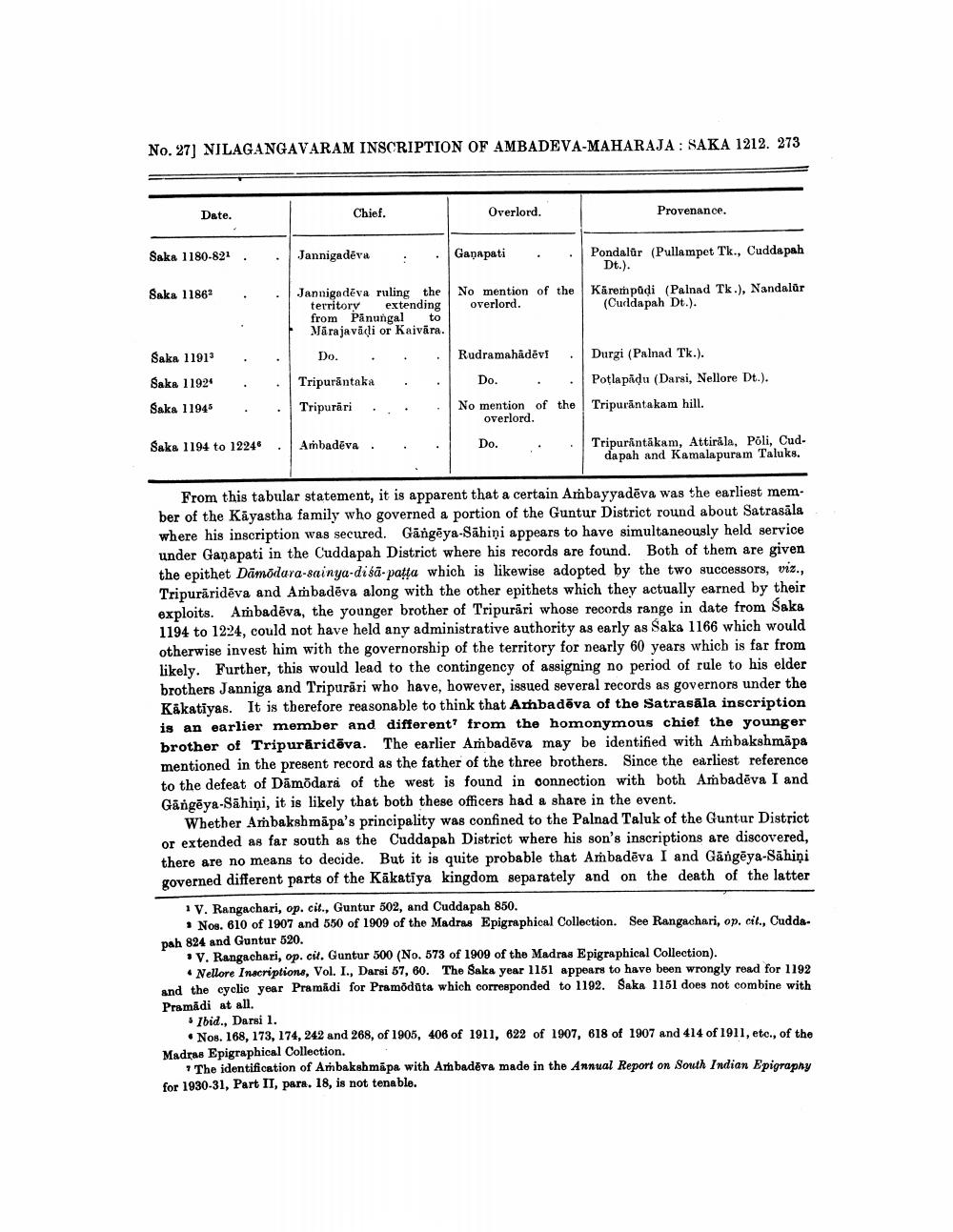________________
No. 27] NILAGANGAVARAM INSCRIPTION OF AMBADEVA-MAHARAJA: SAKA 1212. 273
Date.
Saka 1180-821
Saka 11862
Saka 11913
Saka 11924
Saka 11945
Saka 1194 to 1224
Chief.
Jannigadēva
Jannigadeva ruling the territory extending from Panungal to Märajavadi or Kaivära.
Do. Tripurantaka Tripurari
Ambadeva.
Overlord.
Provenance.
Ganapati
No mention of the Kärempuḍi (Palnad Tk.), Nandalur overlord. (Cuddapah Dt.).
Pondalur (Pullampet Tk., Cuddapah Dt.).
Do.
Rudramahadevi
Do.
No mention of the Tripurantakam hill. overlord.
Durgi (Palnad Tk.).
Potlapadu (Darsi, Nellore Dt.).
Tripurantākam, Attirala, Põli, Cuddapah and Kamalapuram Taluks.
From this tabular statement, it is apparent that a certain Ambayyadeva was the earliest member of the Kayastha family who governed a portion of the Guntur District round about Satrasāla where his inscription was secured. Gängeya-Sahini appears to have simultaneously held service under Ganapati in the Cuddapah District where his records are found. Both of them are given the epithet Damodara-sainya-disa-patta which is likewise adopted by the two successors, viz., Tripurarideva and Ambadeva along with the other epithets which they actually earned by their exploits. Ambadeva, the younger brother of Tripurari whose records range in date from Saka 1194 to 1224, could not have held any administrative authority as early as Saka 1166 which would otherwise invest him with the governorship of the territory for nearly 60 years which is far from likely. Further, this would lead to the contingency of assigning no period of rule to his elder brothers Janniga and Tripurari who have, however, issued several records as governors under the Kakatiyas. It is therefore reasonable to think that Ambadeva of the Satrasala inscription is an earlier member and different' from the homonymous chief the younger brother of Tripurarideva. The earlier Ambadeva may be identified with Ambakshmäpa mentioned in the present record as the father of the three brothers. Since the earliest reference to the defeat of Damodara of the west is found in connection with both Ambadeva I and Gangeya-Sahini, it is likely that both these officers had a share in the event.
Whether Ambakshmäpa's principality was confined to the Palnad Taluk of the Guntur District or extended as far south as the Cuddapah District where his son's inscriptions are discovered, there are no means to decide. But it is quite probable that Ambadeva I and Gängeya-Sahiņi governed different parts of the Kakatiya kingdom separately and on the death of the latter
1 V. Rangachari, op. cit., Guntur 502, and Cuddapah 850.
Nos. 610 of 1907 and 550 of 1909 of the Madras Epigraphical Collection. See Rangachari, op. cit., Cuddapah 824 and Guntur 520.
V. Rangachari, op. cit. Guntur 500 (No. 573 of 1909 of the Madras Epigraphical Collection).
Nellore Inscriptions, Vol. I., Darsi 57, 60. The Saka year 1151 appears to have been wrongly read for 1192 and the cyclic year Pramadi for Pramodüta which corresponded to 1192. Saka 1151 does not combine with Pramādi at all.
Ibid., Darsi 1.
Nos. 168, 173, 174, 242 and 268, of 1905, 406 of 1911, 622 of 1907, 618 of 1907 and 414 of 1911, etc., of the Madras Epigraphical Collection.
The identification of Ambakshmapa with Ambadeva made in the Annual Report on South Indian Epigraphy for 1930-31, Part II, para. 18, is not tenable.




